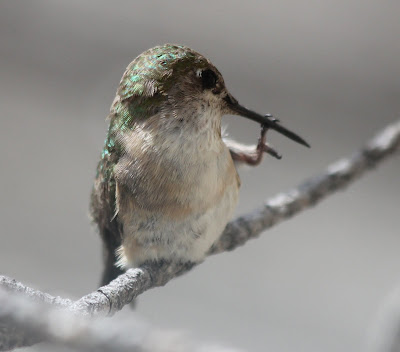 Hmmm. I have been trying to upload a sweet little video of hummingbird pics strung together with music but no luck. Our satellite connection is just too slow for doing some of the very neat things that can be done online these days. She says with a sigh : ) Oh well. Here are the photos anyway ~ onward ever onward.
Hmmm. I have been trying to upload a sweet little video of hummingbird pics strung together with music but no luck. Our satellite connection is just too slow for doing some of the very neat things that can be done online these days. She says with a sigh : ) Oh well. Here are the photos anyway ~ onward ever onward.












One of the smallest hummingbirds, Rufous, are about 3½ to 4 inches long. The male's brilliant scarlet gorget is offset by his rufous-brown back and crown. While his upper breast and belly are white, a pale rufous covers his lower breast and flanks. A black tipped solid rufous tail completes the picture. Females and immatures have white throats and white bellies with green speckles on the edges merging to red speckles in the centre.
While the male is distinctive among North American hummingbirds, identification can be confusing because the species is similar to other hummingbirds, especially Allen's which looks like the female Rufous. This is because, on rare occasions, some male Rufous have partially or mostly green backs, making it difficult to separate them from Allen's. Female and immature Rufous hummingbirds and Allen's hummingbirds are essentially indistinguishable under field conditions. Throughout the West, the Rufous use many different habitats on their migrations. From valley bottom to the alpine, they are very adaptable in their use of the local terrain. Most hummers spend the winter in central Mexico while some winter along the Gulf Coast from Texas to Louisiana, where they are the most common winter hummingbird. In very early spring the Rufous migrates northward using the Pacific Coast exclusively, arriving in Oregon by early March, and Alaska by mid-April. They breed farther north than any other species of hummingbird, ranging from northern California to southern Yukon and into southeastern Alaska. One female Rufous hummingbird averaged 33 miles per day while migrating between Vancouver Island and Tijeras, New Mexico. She was identified in Vancouver the following summer, having traveled 1,373 miles each way. Rufous have the longest migration routes of any hummingbird, with some flying over 5,000 miles per year.
Females arrive at the nesting grounds a few weeks later than the males. When they arrive, the males begin their frenzied activity. Flying in a dizzying series of slanting ovals, he displays for the female sitting quietly below. Shooting upward with his back toward her, he turns, displays his scarlet gorget and dives steeply, barely missing his mate. That whining crescendo you hear as he dives is from the air, which produces a whining noise as it rushes through his feathers. The Rufous hummingbird's wings beat as fast as 200 times per second during these dives. Fueling all this effort after the hummers arrive means they need a constant supply of insects and nectar to maintain their rapid metabolism. And into this story enters their surprising benefactors, the woodpeckers. These industrious birds use old snags as a "drum" to perform part of their mating ritual as well as to define their territory. Woodpeckers feed by drilling holes with their sharp beaks into the bark of living trees, looking for insect larvae.
Next season, these holes bleed sap in the early spring - just as the hummers arrive. The Rufous sucks the sap oozing out these holes and eats the insects trapped within the flow of sap. Seen this way, part of the mystery of early spring feeding is solved. Like the old folk song, the old growth forest is connected to the fir snag, the fir snag is connected to the woodpecker, the woodpecker is connected to to the holes in the bark and the holes in the bark are connected to the hummingbird and all are connected to the mysterious ritual of spring. So the next time you hear a woodpecker drumming, think of hummingbirds. It's just a natural connection.
Thank you Mr Nead!

1 comment:
Very interesting - a great explanation as to why YOU have early hummingbirds there in the Cariboo, and here, further south, they arrive much later. At least in the settled parts of the valley - perhaps there are some in the hills with the bluebirds.
Lovely pictures!
Post a Comment